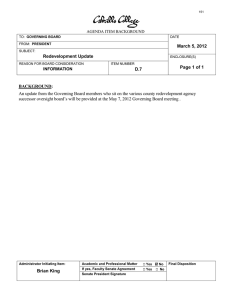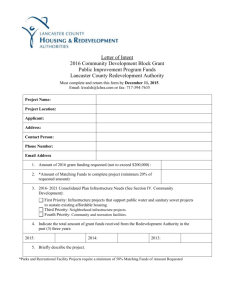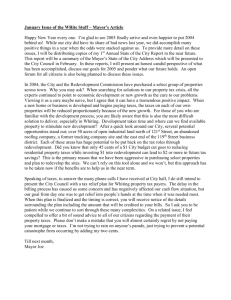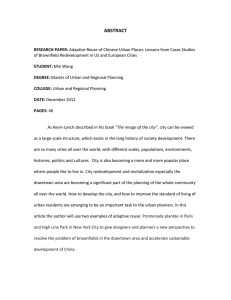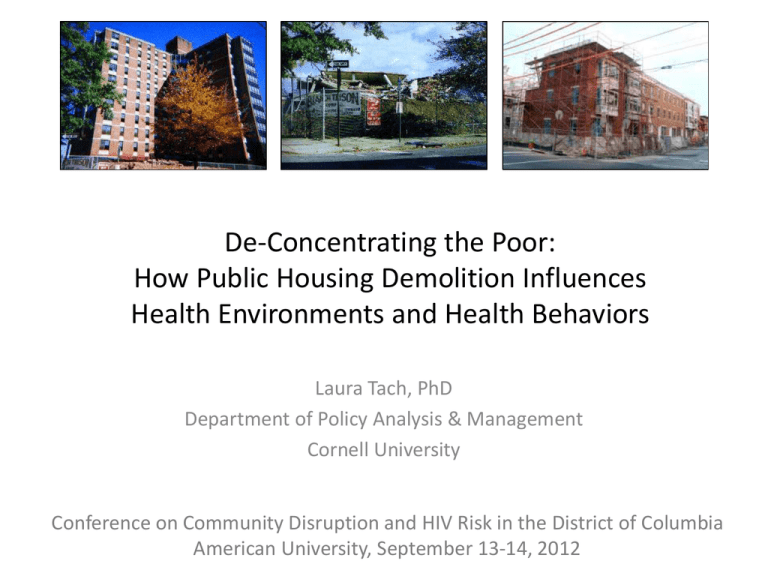
De-Concentrating the Poor:
How Public Housing Demolition Influences
Health Environments and Health Behaviors
Laura Tach, PhD
Department of Policy Analysis & Management
Cornell University
Conference on Community Disruption and HIV Risk in the District of Columbia
American University, September 13-14, 2012
HOPE VI: Origins
Housing Policy to Deconcentrate Poverty
• Origins
– Urban decline
– Concentrated poverty
– Role of housing policy
• 1989: Commission on Severely
Distressed Public Housing
• 1992: HOPE VI
to rebuild distressed public
housing
April 19-21, 2012
RWJF Health & Society Scholars Annual
Meeting
CITIES WITH HOPE VI MIXED-INCOME REDEVELOPMENT PROJECTS
1993-2009
ESRI05USCITIES_DTL
Sheet1$.funds
Less than $1 million
$1-50 million
$50-100 million
0
355
710
1,420 Miles
$100-200 million
over $200 million
Data Source: Author’s tabulations of reports from the
Department of Housing and Urban Development
The Transformation of
High Poverty Neighborhoods
Robert Taylor Homes,
Chicago
Legends South
Techwood Homes,
Atlanta
Centennial Place
Orchard Park,
Boston
Orchard Gardens
HOPE VI in DC
•
•
•
•
•
•
•
Ellen Wilson Homes
Valley Green/Sky Tower
Frederick Douglass & Stanton Dwellings
East Capitol Dwellings
Capper/Carrollsburg
Eastgate Gardens
Sheridan Terrace
The Redevelopment Process
• Grant Application/Award
• Phased Demolition and Construction
– Residents offered a voucher, another public housing unit,
or a spot in new development (if in good standing)
• New developments
– Mix of rental and ownership
– Fractions of units for different income brackets
– Usually reduces density and # of affordable units on site
Philly HOPE Project
Qualitative Study Design
Martin Luther King
Lucien Blackwell
(formerly Mill Creek)
Norman Blumberg
Apartments
HOPE VI Site
Large income mix
Racially diverse
Close to Center City
HOPE VI Site
Shallow income mix
Majority Black
West Philadelphia
Traditional Public Housing
Distressed high +low rises
Majority Black
North Philadelphia
How HOPE VI redevelopment affects risk factors:
- Access to illegal drugs
- Risky sexual activity
- Residential instability & homelessness
- Social networks
- Health care access & preventive care
- Supportive services
Risk Factor: Drug Use
• In Public Housing:
Prevalent Drug Trade
– Easy access to crack cocaine,
heroin, and marijuana
– Certain housing units “known”
as sites for this
– Recovering addicts struggled
with easy availability and
worried about relapsing
– Lack of oversight and
enforcement by public housing
management
Risk Factor: Drug Use
• After Redevelopment:
Greatly Reduced Exposure
– Both leavers and stayers report less
drug availability in their new
neighborhoods
– Redevelopment disrupted drug
distribution networks
– Many of families involved in sales did
not move back (though some did)
– Increased oversight and policing
reduced open air sales and increased
risk of arrest
– Small amounts of crime
displacement (no direct evidence on
drug-related crimes) (Cahill 2011)
Risk Factor: Risky Sexual Activity
• In Public Housing:
– Several female residents sold sex
for rent money
– Certain housing units “known”
as sites for this
– Lack of oversight and
enforcement by public housing
management
– Casual on again, off again
relationships with men in
neighborhood
Risk Factor: Risky Sexual Activity
• After Redevelopment:
– No more housing units
“known” as sites for this
– Increased policing and
housing unit inspections, no
more vacant units
– Formal transactions rarer in
new developments, but
informal exchanges in casual
relationships still persist
– No evidence on movers!
Risk Factor:
Residential Instability & Homelessness
• In Public Housing:
– Housing is more stable
than comparable nonpublic housing
population
• After Redevelopment:
– Housing instability a
cause for concern,
especially among movers
– Small #s report staying in
shelters, but doubling up
is common
– Fear of eviction also a
source of stress among
stayers
Risk Factor: Social Networks
• In Public Housing:
• Social Isolates
– Removed from neighborhood
networks, often as strategy
for keeping safe
• Social Networkers
– Increased social support, but
also
– Increased exposure to
negative peer influences and
risk factors
• After Redevelopment:
– Increased isolation and
disruption of networks among
both movers and stayers
– Described in both positive
and negative terms
– Family networks remain the
same
– Erosion of community-based
institutions for the poor
Risk Factor:
Screening and Preventive Care
• In Public Housing:
– High utilization of city
health clinics
– Near universal receipt of
Medicaid
• After Redevelopment:
- High utilization of city
health clinics
- Near universal receipt of
Medicaid
- Little disruption of care
among stayers
- No evidence on movers!
Risk Factor: Supportive Services
• In Public Housing
– Uneven knowledge of local
supportive services
– No services available on site
– No information distributed by
management
• After Redevelopment:
Stayers:
– Uneven knowledge of local
supportive services
– Some services available on site
– Some linkages with local
nonprofit organizations
– Some information distribution
by management
– CSS funding
• Movers:
– Little knowledge of local services
– Few organizational ties or
methods for outreach
Concluding Thoughts
• Reduction in many environmental risk factors for movers
and stayers
• Increases in housing risk factors, especially for movers
• Countervailing effects on social network risk factors
• Little change in health or supportive services for stayers
– But possibility for intervention in new developments with
Community Supportive Services funds
• No evidence on disruption of services for movers!
• Need to study most ‘at risk’ subset of the public housing
population in more depth
• Possibility for linkages with HOPWA, CSS funds


